6. IntroductionNew technologies can have a revolutionary impact upon the manufacturing state, as was seen during the Industrial Revolution. Computers are in the process of reshaping the modern industry. Manufacturers are rushing to apply this technology to remain competitive. To date a majority of the methods have been limited to enhancing and/or replacing existing manufacturing functions with software. Within the Manufacturing cycle, there are some fundamental functions (as shown in Figure 6.1 The Basic Manufacturing Cycle (Adapted from Rembold et. al. [1985], pp.30)). The figure depicts one particular view of manufacturing suggested by Rembold et. al. [1985]. It is easy to see the complexity of the interactions between functions. Most of these functions have been automated for Accounting, Monitoring and Control, Time Scheduling and Organizational Planning. However, planning for all aspects of manufacturing has been very difficult to computerize because of its highly abstract and time variant nature. The systems that can do so are limited to very small domains. All of the systems for limited domains create a need for a system that will make higher level decisions between production technologies. In general terms, new product development is a function of; i) Design, ii) Process Planning, iii) Scheduling, iv) Control, and v) Manufacturing. The Design function has been supplemented with Computer Aided Design (CAD) and Computer Aided Engineering (CAE) tools that enable the modeling of geometry, analysis of stresses and 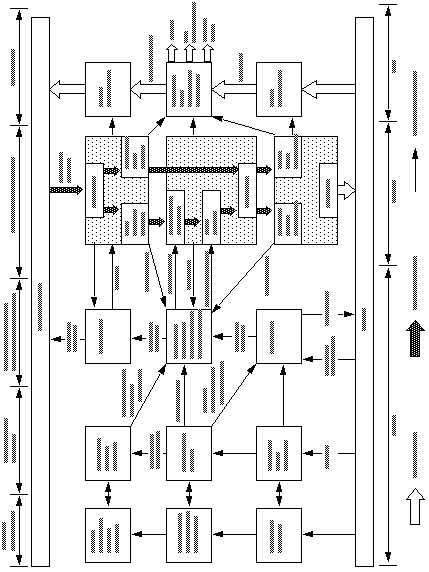
Figure 6.1 The Basic Manufacturing Cycle (Adapted from Rembold et. al. [1985], pp.30) heat flow, evaluation of tooling, and other sophisticated problems to be defined. During process planning, the design is converted into a list of operations and resources that are required to direct production. Up to this point products and parts are dealt with individually. During scheduling, the process plans for a number of products are considered together as required by the customer orders. Finally, the Production Control function ensures that the schedules are being adhered to in a reasonable manner. The weakest link in the CIM (Computer Integrated Manufacturing) philosophy is Process Planning. The deficiencies of process planning have not resulted from a lack of effort by researchers. As early as 1965 the concept was discussed by Niebel [1965]. By 1988, Alting and Zhang [1988] listed 156 existing CAPP systems, of which 49 where alleged to be available commercially. Despite the large number of commercial packages, there are several reasons why CAPP systems have not been widely utilized to date: Very limited process planning domains. Input is difficult, and often not from a common CAD package. One of the major hypotheses of this thesis is that the main reason for the shortcomings of process planning is a result of the method of product representation. This thesis aims to explore a new representation method which enhances the product representation using Boolean equations. The use of Boolean equations enables a new group of methods to be used to manipulate and analyze designs to eventually produce process plans. A simple job shop, with only a few machines, can do process planning using experience and intuition. But, as the size of the factory grows, and the permutations and combinations of options grows, so does the complexity. This creates a need for specialists called Process Planners who use their experience and detailed knowledge to select the method of production. Requicha and Vandenbrande [1988] describe the task of process planning as: “A process planner and a set-up planner (often the same person) examine a part’s blueprint and consult various files and handbooks to produce a process plan. A plan contains process specifications and information on fixtures and clamping devices to be used, and on set-up of the work-piece on a machine tool. Set-up specifications are typically conveyed through annotated sketches or engineering drawings.” Requicha and Vandenbrande describe the process planning operation as a two step process, as shown in Figure 6.2 Traditional Two-Stage Approach To Process Planning (Adapted from Requicha & Vandenbrande, 1988, pp.302). 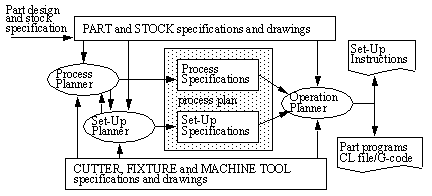
Figure 6.2 Traditional Two-Stage Approach To Process Planning (Adapted from Requicha & Vandenbrande, 1988, pp.302) The first step involves the abstract phases of Process Planning and Set-up Planning. In the second stage, Operation Planning is used to assign details to the operations in the process plan. The final result of process planning can be as shown in Figure 6.3 A Sample of a Process Plan Found in Industry. This sheet emphasizes the ad-hoc nature of data identification, and plan completeness. Many details are cryptic, or must be completed at the machine by the operator. 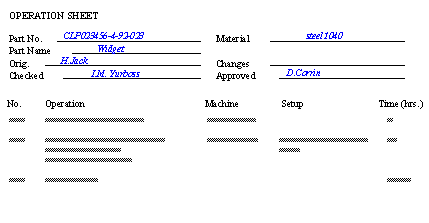
Figure 6.3 A Sample of a Process Plan Found in Industry The details in a process plan can have a profound impact on the cost of a product and this makes many manufacturers justifiably cautious about change. Employees that do process planning are often long-term employees with a great deal of experience. Companies recognize that it is difficult to capture the knowledge of these individuals. One of the first types of Computer Aided Process Planning (CAPP) systems is generally classified as Variant. These systems ‘look-up’ plans created previously and allow them to be edited to suit new parts. These systems have not replaced the process planner, but they have increased productivity, decreased costs, and reduced mistakes. To date these have been the most successful planners used in industry [Nolan, 1989]. Generative CAPP systems have more potential than the Variant systems, but are still undergoing development within the research community. At their simplest, Generative systems help a designer select operations. More complicated versions promise to fully automate planning. But, to replace the knowledge of a process planner is not a trivial task. Hence, the techniques of Artificial Intelligence (AI) have become very popular in CAPP. Many of the Generative systems are limited to small domains of manufacturing, such as machining, assembly, etc. This is necessary because of the difficulty in capturing knowledge for performing tasks. Systems of restricted production domains are of limited use to a manufacturer. There is a need for a CAPP system is required that plans at a higher level and then, in turn, activates lower level CAPP systems for more detailed planning. Within process planning the source of the plans is the key method of classification. The three basic classifications are Variant, Generative, and Automated [Chang, 1990]. A Variant CAPP system reuses or references standard process plans created previously. Old designs and their plans are recalled by matching abstract codes for the new designs to those of previous designs. The process plan from the old design is then customized for the new design [Nolan, 1989]. In this mode the CAPP system is essentially a plan editing system. This method can be fast to set up, but can be much slower when creating new process plans. In a Generative CAPP system there are no stored plans. Each new plan is created using techniques including dedicated algorithms and Artificial Intelligence. These systems take longer to set up, but are much faster when executing. Nolan [1989] states that these systems have only been successful for very limited cases with well defined planning problems. The third method, as suggested by Chang [1990], is Automated CAPP. This describes a generative CAPP system that runs without operator intervention. Naturally this system is more theoretically demanding, and must have extensive error checking and plan verification functions to replace those of the human planner. This thesis describes a system called BCAPP (Boolean Computer Aided Process Planning) that is capable of planning at a high-level based upon design information. This system looks for clues about which rules (and consequently technologies) are useful. These rules operate on a design stored with Boolean equations of sets, where the sets describe primitive geometries. The planner is not intended to develop all of the detailed operation parameters for the production steps, but it will easily develop high-level plans with mixed production domains. A CAPP module for detailed plans of operations was also created for verification. The interested reader looking for introductory material on Process Planning is directed to Muchnicki [1987], Wang and Wysk [1988] and Nolan [1989]. To aid the reader, a summary of the approach is given here before the details are presented. To begin with we have a design for a part as shown below with the final geometry, the primitives, the Boolean expression that describes it, and some equivalent representations. 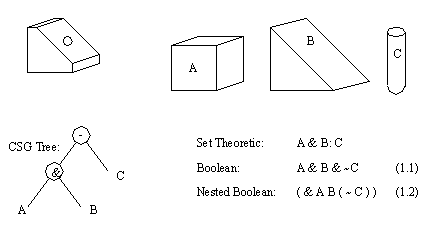
Figure 6.4 A Sample Part and Some Theoretical Representations Although the Nested Boolean representation is used in this thesis for BCAPP, and is equivalent to the other models, the Boolean equation will be used for this descriptive example. First the reader is asked to look at the equation (1.1), and notice that certain equation forms suggest certain operations. If we look at the ‘~C’ term ANDed with the other primitives, this tends to suggest machining out of some internal feature such as the a drilling operation. In this case the two other primitives that are ANDed suggest that one is a piece of stock and the other primitive defines some external features to be machined off (as well as other operations). The following steps show how a simple planner would use this approach. 1.a) Start with equation ‘A & B & ~C’. 2.a) Perform a drilling operation. b) Remove ‘~C’ to get remaining equation of ‘A & B’. 3.a) Perform a milling operation to remove material outside wedge, but in the block volume. b) Remove ‘B’ from the equation to leave only ‘A’. 4. a) Cut block of dimensions for ‘A’ from stock. b) Remove ‘A’ from the equation to leave an ‘NULL’ expression. 5.a) Quit because there is no design equation left to interpret. A previous criticism of trying a method like this is non-uniqueness, but this has been used to advantage. For example, if we take the previous design equation (1.2), and rearrange it using the Laws of Boolean Algebra, we can get the equivalent expression (1.3). 
The double negative can suggest a molding or casting type process. In effect the term, 
describes the molding cavity (everything around the part ‘A & B & ~C’ is solid, and the space for the part is now the only void location), and the second negation indicates an injection of material into the void location. We can also observe that the primitives ‘A’ and ‘B’ would generally enlarge the cavity volume, whereas ‘~C’ would create an obstruction when milling the cavities. It is these sort of clues that make this method well suited to the abstract nature of Artificial Intelligence (AI) planning. A similar example to this sort of reasoning can be seen in Shpitalni, et. al. [1991]. The main objective of this thesis is to develop a computerized process planning system that generates near optimal process plans for mixed production technologies. The system will be based on product models described by Boolean equations. As directed by the main objective, a more specific set of objectives were selected to give the research some direction and criteria for evaluating the final success of the approach. These are given in the short list below: Be able to recognize alternative production technologies for manufacture of product features. This requires the planner to be able to consider multiple planning domains. Be able to produce alternative operations for each feature. Allow some degree of innovation in the process plan,. Permit a structure that allows feedback of production problems to the process planner. To allow the computer to reduce the knowledge barrier between process planning and production. Minimize human effort and intervention when process planning. Be capable of accepting new manufacturing technologies without fundamental changes in the process planner. Be able to optimize process plans. Simplify the problem of recognizing features from the design. Many authors have used some or all of these goals when developing process planning systems, as will be seen in the literature review. An overview of the theory and software is presented here to help the reader keep the organization of the thesis in perspective. At present, BCAPP uses information from two different sources to find process plans. One input is the design definition. This definition is in the form of Boolean equations that act upon sets, as seen in the intuitive example. The approach to product modeling is described in detail in chapter 3. The second source of information is the manufacturing resources definitions. These are in the form of rules that describe available processes and requirements. Chapter 5 covers the details of modelling and selection of the resources. Both the design and rule files are used by the process planner. The planner is described over 3 chapters. The fundamentals of CAPP systems are covered in Chapter 2. In Chapter 4 the basics of Artificial Intelligence Planning systems are covered. Finally, in Chapter 5 the implementation for the BCAPP planning system is presented. The major contribution of the thesis is; the design representation in Chapter 3 and the rules and planner in Chapter 5. Chapter 6 describes a system that acts as a post processor for the high level planner. The material covered in Chapter 6 represents the role of other process planning systems that are designed for specific manufacturing technologies. Finally, Chapters 7, 8 and 9 present examples of the planners successes and failures, discuss the results, and suggest future work. The layout for the software is shown in Figure 6.5 The BCAPP Approach to Process Planning below. The product description file is at present provided by the user in the format described in Chapter 3. Eventually this could be provided by a commercial CAD package with minor modifications. The technology rule file is also provided by the user. This rule file must be developed so as to describe all resources in a factory. At present this file would have to be created by a trained Knowledge Engineer. Eventually the rule file could be entered through some inductive learning rule generation software. 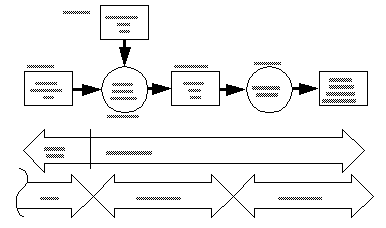
Figure 6.5 The BCAPP Approach to Process Planning The process planning software (BCAPP) will accept the design file and the rule file, and attempt to find a process plan. The process plan steps will be added to the design file. At this point the process plan contains suggested operations and alternates, but it does not contain many details. (Please note that the contribution of this thesis is in the stages up to and including BCAPP, subsequent sections are provided for support only). After the high-level process plan is passed on, it is picked up by the operation planner (as described in chapter 6). This software will use existing CAPP systems to provide details necessary for production. In addition to this, the software must determine the operation sequences and deal with production failures. If, for some reason, a process plan cannot be executed then it is possible to restart BCAPP to provide more alternatives. The following sections of this thesis begin with a review of process planning research that will be of particular use to readers not familiar with the current state of the topic (Chapter 2). After this, the area of solid modeling is reviewed briefly and then the modelling method used in this thesis is reviewed (Chapter 3). There is a subsequent discussion of the rules used for the design (Chapter 4). Next there is a discussion of the AI planning system that applies the rules to produce the process plans (Chapter 5). A short section is presented on operation planning to show how plans are detailed for factory use. After the background is laid out for the thesis, a set of demonstration examples are given to show the strengths and weaknesses of the approach (Chapter 7). As the thesis concludes, a discussion of problems and future work is presented. |